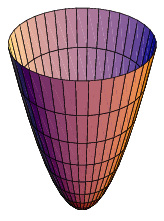
Paraboloid, an open surface generated by rotating a parabola (q.v.) about its axis. If the axis of the surface is the z axis and the vertex is at the origin, the intersections of the surface with planes parallel to the xz and yz planes are parabolas
The surface of revolution of the parabola which is the shape used in the reflectors of automobile headlights
Its equation is given by -
The paraboloid which has radius a at height h is then given parametrically by
A circular or elliptical paraboloid surface may be used as a parabolic reflector. Applications of this property are used in automobile headlights, solar furnaces, radar, and radio relay stations.
In a suitable Cartesian coordinate system, an elliptic paraboloid has the equation {\displaystyle z={\frac {x^{2}}{a^{2}}}+{\frac {y^{2}}{b^{2}}}.}{\displaystyle z={\frac {x^{2}}{a^{2}}}+{\frac {y^{2}}{b^{2}}}.} If a = b, an elliptic paraboloid is a circular paraboloid or paraboloid of revolution. It is a surface of revolution obtained by revolving a parabola around its axis. Obviously, a circular paraboloid contains circles. This is also true in the general case (see Circular section). From the point of view of projective geometry, an elliptic paraboloid is an ellipsoid that is tangent to the plane at infinity.
The plane sections of an elliptic paraboloid can be:
a parabola, if the plane is parallel to the axis,
a point, if the plane is a tangent plane.
an ellipse or empty, otherwise.
On the axis of a circular paraboloid, there is a point called the focus (or focal point), such that, if the paraboloid is a mirror, light (or other waves) from a point source at the focus is reflected into a parallel beam, parallel to the axis of the paraboloid. This also works the other way around: a parallel beam of light that is parallel to the axis of the paraboloid is concentrated at the focal point. For a proof, see Parabola § Proof of the reflective property. Therefore, the shape of a circular paraboloid is widely used in astronomy for parabolic reflectors and parabolic antennas. The surface of a rotating liquid is also a circular paraboloid. This is used in liquid-mirror telescopes and in making solid telescope mirrors (see rotating furnace).
The hyperbolic paraboloid is a doubly ruled surface: it contains two families of mutually skew lines. The lines in each family are parallel to a common plane, but not to each other. Hence the hyperbolic paraboloid is a conoid. These properties characterize hyperbolic paraboloids and are used in one of the oldest definitions of hyperbolic paraboloids: a hyperbolic paraboloid is a surface that may be generated by a moving line that is parallel to a fixed plane and crosses two fixed skew lines. This property makes it simple to manufacture a hyperbolic paraboloid from a variety of materials and for a variety of purposes, from concrete roofs to snack foods. In particular, Pringles fried snacks resemble a truncated hyperbolic paraboloid.[4] A hyperbolic paraboloid is a saddle surface, as its Gauss curvature is negative at every point. Therefore, although it is a ruled surface, it is not developable. From the point of view of projective geometry, a hyperbolic paraboloid is one-sheet hyperboloid that is tangent to the plane at infinity. A hyperbolic paraboloid of equation {\displaystyle z=axy}{\displaystyle z=axy} or {\displaystyle z={\tfrac {a}{2}}(x^{2}-y^{2})}{\displaystyle z={\tfrac {a}{2}}(x^{2}-y^{2})} (this is the same up to a rotation of axes) may be called a rectangular hyperbolic paraboloid, by analogy with rectangular hyperbolas.
A plane section of a hyperbolic paraboloid with equation {\displaystyle z={\frac {x^{2}}{a^{2}}}-{\frac {y^{2}}{b^{2}}}}{\displaystyle z={\frac {x^{2}}{a^{2}}}-{\frac {y^{2}}{b^{2}}}} can be a line, if the plane is parallel to the z-axis, and has an equation of the form {\displaystyle bx\pm ay+b=0}{\displaystyle bx\pm ay+b=0}, a parabola, if the plane is parallel to the z-axis, and the section is not a line, a pair of intersecting lines, if the plane is a tangent plane, a hyperbola, otherwise.
Saddle roofs are often hyperbolic paraboloids as they are easily constructed from straight sections of material. Some examples: St. Mary's Cathedral, Tokyo, Japan (1964) Cathedral of Saint Mary of the Assumption, San Francisco, California, USA (1971) Saddledome in Calgary, Alberta, Canada (1983) L'Oceanogràfic in Valencia, Spain (2003) London Velopark, England (2011)